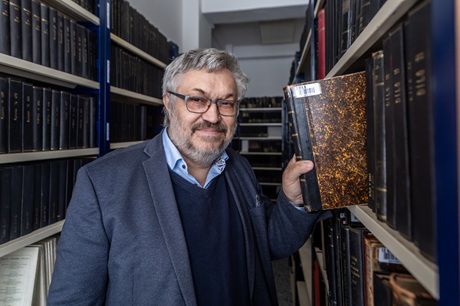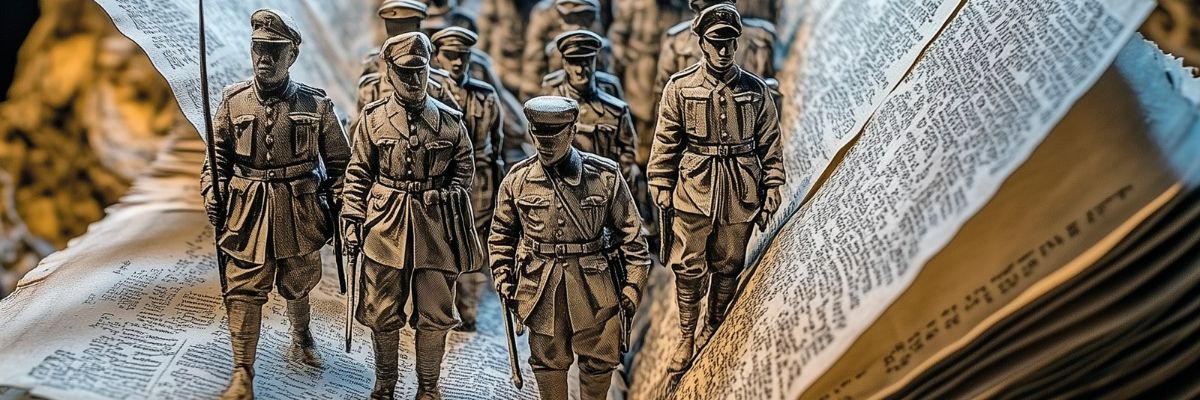
Literature is tied to its historical context. How can we read between the lines?
28. 03. 2025
A deeper subtext often lies beneath the seemingly innocent stories of literary works written during the Protectorate of Bohemia and Moravia. Understanding it, however, requires more than just knowledge of literature. “The line between interpretation and misinterpretation is a very thin one,” says Pavel Janoušek from the Institute of Czech Literature of the Czech Academy of Sciences (CAS). In an article first published in the quarterly A / Magazine of the CAS, the literary historian reveals how deciphering historical context can enrich our insight into literary works.
“Manon, o Manon, Manon from Arras! Manon is my ‘to die for beauty.’” The story of the capricious Frenchwoman, the devotion of Chevalier des Grieux, and the evocative verses of Vítězslav Nezval still continue to enchant readers and spectators alike. The play Manon Lescaut is well-known in the Czech Republic. Yet, few today fully grasp its original message. If you are Czech and are struggling to recall your high school literature lessons, wondering what else besides the love story there is to the play, then read on.
Nezval’s verse drama premiered at the D 34 Theater (Prague) in April 1940, that is, during World War II and the Protectorate of Bohemia and Moravia. It became an immediate hit. Before the theater was closed in March 1941, nearly 90,000 spectators had seen the play in that theater alone, with many other productions taking place at other venues. The play also came out in dozens of print editions. Manon managed to capture not only the heart of her devoted knight, but also those of audiences and readers. In a poll conducted by Czech newspaper Lidové noviny, Manon Lescaut was overwhelmingly voted the most-read book of 1940 and would likely have continued breaking publishing records in the coming years – had the Nazis not banned further performances and editions.
When Manon Lescaut was performed at the time, it was a cultural phenomenon beyond what we can imagine today. Yet, after the war, few truly understood why. It was commonly assumed that its success was due primarily to its beautiful verse, which stood in defiance of the threatened Czech language. “Before writing the chapter on drama for our book, I was, of course, familiar with the play. But only by placing it in its historical context did I fully grasp its original subtext and why it resonated so deeply with audiences,” says Pavel Janoušek from the Institute of Czech Literature of the CAS and chief editor of the book Dějiny české literatury v Protektorátu Čechy a Morava (History of Czech Literature in the Protectorate of Bohemia and Moravia).
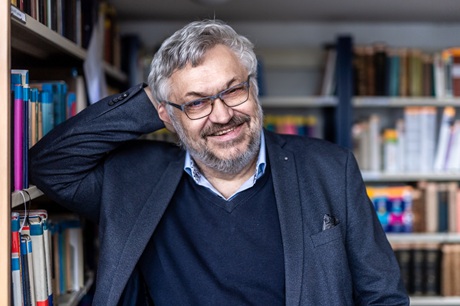
Pavel Janoušek from the Institute of Czech Literature of the CAS. (CC)
Later generations forgot that Manon Lescaut had entered the stage at the moment when Germany invaded France. Is it now clearer to see what Nezval was really portraying, beyond Manon’s whims? “To the audiences of the time, Manon was France – the country that had betrayed us in Munich. A fickle woman whom we still loved despite everything,” the researcher explains. Of course, no one could openly state that Manon personified France. But contemporary viewers read between the lines and understood the allegory well.
“This is one of the many challenges of literary criticism and the reason why we must continually study literature. And that’s because it is always tied to the circumstances and context in which it was created – sometimes quite tightly. And yet, every reader will interpret it differently, influenced by their own time,” Janoušek explains.
The black hole of the Protectorate
During the Protectorate, when political expression was silenced, literature and theater played an especially crucial role in defining national identity. They provided a means to respond to current events, and in theaters, audiences could at least briefly escape the harsh realities of everyday life.
|
The History of Czech Literature in the Protectorate of Bohemia and Moravia The 2022 collective monograph Dějiny české literatury v Protektorátu Čechy a Morava examines the literary period of 1938–1945, exploring how it was shaped by events such as the Munich Agreement and the German occupation. It also delves into the political, social, and literary life of the time, including censorship. The book highlights not only literature published during the Protectorate, but also literary works created in prisons, concentration camps, and exile. It covers poetry, prose, drama, and nonfiction, as well as popular and children’s literature. At the 2023 Academia Publishing Awards, it was named Book of the Year. |
It can be said that the literature of this era (1939–1945) later became a neglected phenomenon – a sort of black hole in Czech history. It didn’t fit neatly into the narrative of national identity. “Interest in the interwar period and the geo-political postwar communist development in Czechoslovakia overshadowed it. This in-between time was seen as an awkward detour, especially as writers’ responses to German pressure had to be examined – who conformed, who wavered, and who resisted,” Janoušek says.
Moreover, the Nazi regime had striking parallels with the later communist one. Once again, society was expected to conform to a single ideology, leading to similar methods of coercion and control. During the communist rule, pointing out these similarities was not welcomed.
As a result, only a handful of Protectorate-era works were remembered in schools and public consciousness: besides Manon Lescaut, Janoušek cites Největšího z Pierotů (The Greatest Pierrot) by František Kožík (1939), Kámen a bolest (Stone and Pain) by Karel Schulz (1942), and the humorous novels Saturnin by Zdeněk Jirotka (1942) and Bylo nás pět (We Were a Handful) by Karel Poláček (written 1943, publ. 1958).
Games of hide-and-seek
Initially, the Nazi regime claimed it would not severely restrict Czech cultural life. It even turned a blind eye to minor subtexts. Czech censors that oversaw editorial boards, publishers, and theaters often pretended not to notice any politically problematic content. Over time, however, tolerance diminished. Authorities began banning the publication and productions of specific works and authors, tightening control over new texts themselves down to individual words and sentences. In E. F. Burian’s 1940 adaptation of Viktor Dyk’s Krysař (The Pied Piper), for instance, censors significantly reduced the frequency of the word “rat.” As new productions of Czech and foreign plays were increasingly limited, some theaters were shut down. Others, like the National Theater, had to continue operating to maintain the illusion of normalcy.
One example of escalating censorship is Olga Scheinpflugová’s play Hra na schovávanou (Hide-and-Seek). The play’s protagonist, Dora Fričová, initially appears in the role of a naive wife guided and protected by her husband, a textile factory owner. But when unscrupulous distant relatives nearly strip them of everything, Dora reveals herself as a strong, modern woman who has the drive and verve to rebuild the business, restoring hope to her family and workers.
A harmless feminist tale with a happy ending? On the surface, yes – unless you know the historical circumstances. The play premiered in Prague in November 1939. Its author – who played the lead role of Dora – had, as per the play’s title, allegorically woven a subtle patriotic message into the seemingly apolitical work by way of the characters’ names.
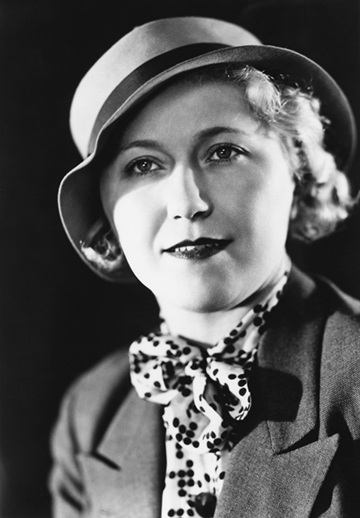
Olga Scheinpflugová, author of the play Hra na schovávanou (Hide-and-Seek), among others, was one of the writers banned during the Protectorate.
The villainous relatives were given the German surname “Schneider.” The drama, then, was not just about the peripeteia of one Czech family – it was an allegory of the fate of the entire nation. When the German relatives unjustly seized the family’s property (symbolizing the annexation of Sudetenland) and a devastating fire struck the textile factory (the dissolution of Czechoslovakia), the play emphasized resilience and hope for a better future.
According to Janoušek, everyone involved in the production felt the political subtext was obvious. “They expected questions. Olga Scheinpflugová, the playwright and lead actor, was even prepared to prove that she had relatives named Schneider,” the researcher says. Initially, no objections were raised, and the play appeared on amateur and professional stages. However, in early 1940, a Czech county representative reported it to the German authorities, resulting in the theater in České Budějovice having to pull the play, leading to a ban in 1941. What followed was a ban on all the author’s other works as well.
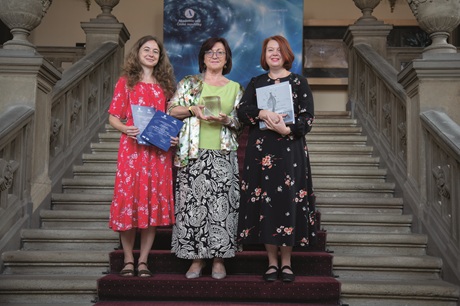
Co-editors of History of Czech Literature in the Protectorate of Bohemia and Moravia. From left, Alena Šidáková Fialová, Iva Málková, and Kateřina Piorecká. (CC)
By September 1941, with the arrival of acting Protector of Bohemia and Moravia Reinhard Heydrich to Prague, any last remnants of leniency of the Protectorate authorities vanished for good. The Nazis banned anything that might foster even a semblance of national hope – including Manon Lescaut. “Drama reflects reality, even allegorically. The censors’ fear of appearing lax in the eyes of their superiors led them to block anything remotely suspicious,” Janoušek notes.
Bottom-drawer manuscripts
Naturally, then, the authors of History of Czech Literature in the Protectorate of Bohemia and Moravia also had to contend with literary works written, so to speak, “for the bottom drawer” – pieces never destined for publication under the oppressive conditions of the time. One such example cited by the researcher is Viděla jsem Boha (I Saw God), a play by the aforementioned Olga Scheinpflugová. She wrote it while blacklisted as a banned author. The drama tells the story of an ordinary woman who manages to topple the rule of a cruel despot after discovering that God exists and sharing her revelation with the people. After the war, the play was performed and published, only to later fade into obscurity.
Other “bottom-drawer plays” from the Protectorate era, however, did find lasting recognition. One enduring example is Jan Drda’s 1942 allegorical fairytale Hrátky s čertem (Playing with the Devil), in which a fearless Czech hero, with the help of angels, triumphs over hell – an unmistakable metaphor for Nazism. The play remains popular to this day, though Drda revised it after the war. In the newer version, the victory belongs to the people, who force even highwaymen and priests to labor for the common good – symbolized by turning the wheel of a water mill.
“When it comes to works hidden away in drawers, it was easier for me, writing the chapter on drama, than it was for my colleagues,” the literary scholar explains. “That’s because drama craves the spotlight and longs for the stage. If playwrights can’t get their work produced, they tend to write something else instead. Readers will find more ‘bottom-drawer’ works in the chapters on poetry and prose.”
|
Czech literature under the microscope Thanks to the support of the Academic Award of the CAS, Pavel Janoušek’s team was able to produce not only the aforementioned book on Protectorate-era literature, but several other monographs as well. The latest addition, the first volume of Gesto a skutečnost. Umění v meziválečném Československu (Gesture and Reality: Art in Interwar Czechoslovakia), explores the relationship between art and politics and highlights the diversity of interwar artistic production under the leadership of Kateřina Piorecká. At the beginning of 2025, readers will have access to Moderní česká divadelní hra 1896–1945. Mezi textem a inscenací (Modern Czech Theatre Play 1896–1945: Between Text and Production), edited by Aleš Merenus, as well as V souřadnicích neklidu (The Coordinates of Unease), with Alena Šidáková Fialová as the lead editor. The latter publication will provide insight into the literary landscape of the 1920s and analyze key works that emerged during this period. |
Writers of the Protectorate era still had some leeway to express their emotional reactions to the times they lived in – through historical plays. These works were obviously based on real events, but certain topics remained off-limits, such as major Czech defeats or victories. That’s why playwrights focused on moments from history that would engage audiences.
One such moment was the story of Petr Vok and his lifelong companion, which Jan Bor adapted into the play Zuzana Vojířová based on František Kubka’s short stories. This drama of great love defended the right to a free life. Many authors also often chose to set their works in distant, exotic locations. “It’s telling how often they turned to Japan, for instance,” notes one researcher. “From the German perspective, Japan was an unproblematic country, and for Czechs, it was an unusual, attractive setting.”
The art of interpretation
The reception of these plays could sometimes be surprisingly nuanced. A striking example is Caesar, a play written in 1942 by František Zavřel, who presented himself as an admirer of Mussolini’s fascism. The play conveys ideas that could be read as support for the regime of the time. Yet Caesar remained on the stage of the National Theater for more than a year, enjoying dozens of repeat performances.
Its popularity may have been due to Jiří Frejka’s skillful direction, Zdeněk Štěpánek’s powerful performance in the lead role – or, importantly, the possibility of an alternative interpretation. Some members of the audience may have been drawn to the play precisely because of Caesar’s infamous downfall as a ruthless dictator, while his adversary Vercingetorix could be seen as an embodiment of heroic resistance – one who would rather face execution than submit to foreign rule and serve as a “protector” in his own land.
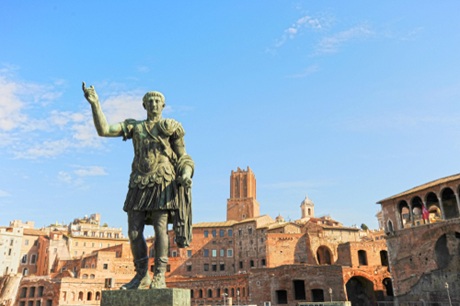
A bronze statue of Julius Caesar – military commander, politician, and one of the most powerful figures in ancient history.
Many literary scholars argue that the author’s intended meaning doesn’t matter – what matters is how the audience perceives the work. But as Janoušek suggests, the truth lies somewhere in between: “You’ll often come across the claim that there’s no such thing as a ‘wrong’ reading. Personally, I disagree. For instance, if you ignore or are unaware of the historical context. The line between interpretation and misinterpretation is a very thin one.”
That’s why his team’s book explores the various contexts surrounding literary creation. “Essentially, our work is a dialogue with the past conducted in the present, and addressed to contemporary readers,” Janoušek explains. Studying literature is often like having an imaginary conversation with authors and their works. For scholars, this means not only examining history and the authors’ biographies, but also engaging with other artistic texts from the same era.
So why should we revisit literature from long-gone times? “These days especially, when we keep hearing that artificial intelligence will soon replace all intellectual labor, we should recognize the importance of maintaining a dialogue with our own past. We need to see in which ways our ancestors were just like us – and which of their works appear (or don’t appear) in textbooks or on the internet,” Janoušek notes.
It pays off to revisit traditional views of culture from time to time, but always in relation to the era in which they emerged. “In literature, we constantly experience the tension between the original meaning of words and texts and their present-day interpretations. By ‘decoding’ the past, we can enrich our knowledge and help change how modern readers perceive authors and their works,” Janoušek concludes. Thanks to such resurrected context, we may even come to a deeper understanding of the faithless Manon Lescaut.
*
|
Prof. PhDr. Pavel Janoušek, DSc.
Pavel Janoušek studied Czech language, art education, and theater and film studies at the Faculty of Arts, Charles University in Prague. He has been affiliated with the Institute of Czech Literature (formerly the Institute of Czech and World Literature) of the CAS since 1989, serving as its director from 1999 to 2011. Between 2013 and 2017, he was a member of the Academy Council of the CAS. From 1990 to 2024, he headed the Department of 20th-Century and Contemporary Literature at the institute while also lecturing at the Theater Faculty of the Academy of Performing Arts in Prague. His research primarily revolves around the history of Czech literature, particularly 20th-century drama and prose, as well as literary and theater theory and literary criticism. In 2018, he was awarded the Academic Award of the CAS, and in 2024, he received the Josef Dobrovský Honorary Medal for Merit in Philological and Philosophical Sciences. |
*
The article was first published in Czech in the 4/2024 issue of the CAS quarterly A / Magazine:
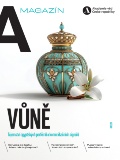
4/2024 (version for browsing)
4/2024 (version for download)
Written and prepared by: Zuzana Dupalová, External Relations Division, CAO of the CAS
Translated by: Tereza Novická, External Relations Division, CAO of the CAS
Photo: Midjourney; Jana Plavec, External Relations Division, CAO of the CAS; ČTK; Shutterstock
 The text and photos labeled CC (including Pavel Janoušek’s bio photo) are released for use under the Creative Commons license.
The text and photos labeled CC (including Pavel Janoušek’s bio photo) are released for use under the Creative Commons license.
Read also
- New record set for neutrino mass: one million times less than an electron
- On the trail of the endangered little owl: searching for newly hatched owlets
- Teen scientist breaks barriers: No child is a lost cause
- The Czech Academy of Sciences has appointed its new leadership for 2025–2029
- Radomír Pánek: The Academy must be united, strong, and proactive
- A springtime booster: The healing potential of tree buds
- A novel compound that protects bone cells may benefit diabetic patients
- New interactive exhibition at the CAS showcases materials shaped by genius ideas
- Leaf growth, root formation, and reproduction – Look to hormones for the answer
- Without volcanoes, life on Earth wouldn’t exist, says Lukáš Krmíček
The Czech Academy of Sciences (the CAS)
The mission of the CAS
The primary mission of the CAS is to conduct research in a broad spectrum of natural, technical and social sciences as well as humanities. This research aims to advance progress of scientific knowledge at the international level, considering, however, the specific needs of the Czech society and the national culture.
President of the CAS
Prof. Eva Zažímalová has started her second term of office in May 2021. She is a respected scientist, and a Professor of Plant Anatomy and Physiology.
She is also a part of GCSA of the EU.
